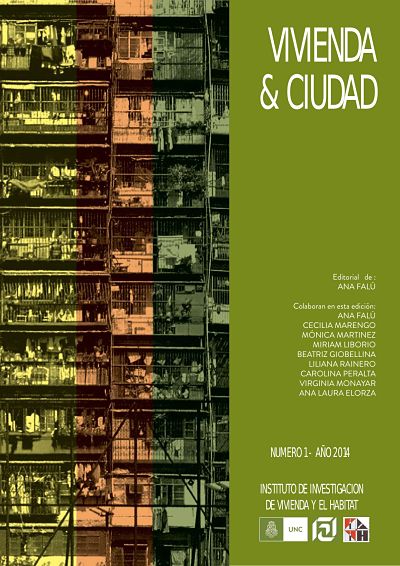Las formas de la informalidad
Keywords:
Urban informality, Ground access, Housing accessAbstract
The increasing urbanization of population and poverty has resulted in a growing demand for land, housing and urban services. In the social, economic and political local context of the last decades, this are provided by the market or by the state, although the most cases the population is self-producing their habitat, consolidating situations of urban informality. What and how is the informal production of habitat? Why is produced and reproduce despite the programs and policies implemented by governments? These are some of the questions that this paper seeks to address. The municipality of Cordoba, Argentina’s second largest city by the number of inhabitants, has an urban population of over 90% and about 7% of the population lives informally. Over the past two decades, governments have implemented mitigation actions towards informality; despite these actions, informality still occurs. Furthermore, it consolidates and it increases it density. Informality is a complex problem and, as such, it responds to multiple factors. This paper approaches an analysis of it in the municipality of Córdoba from the relationship between the land accessibility from formal logic, the forms of urban informality and the housing policies, without affirming that the study of the topic is understood only by these variables. Urban informality is addressed in the municipality of Cordoba, where despite many or few and not very diverse programs implemented as part of housing policy, the problem has not been possible to be reduced. Given this, the underlying assumptions that housing policies are based on formal logics that have little understanding of the ways informal occupation of urban space occurs.References
ALTIMIR (1997). Desigualdad, empleo y pobreza en América latina: efecto del ajuste y del
cambio en el estilo de desarrollo. Desarrollo Económico (37) Nº 145 pp3-30.
ARRIAGADA (2000). Pobreza en América Latina: Nuevos escenarios de políticas para el hábitat
urbano. Santiago de Chile: CEPAL, División Medio ambiente y Asentamientos Humanos.
BORJA, Jordi (2003). La ciudad conquistada. Madrid: Alianza Ed.
BOUILLON, Cesar (2012). Un espacio para el desarrollo. Los mercados de vivienda en América
Latina y e Caribe.Consultado en
http://idbdocs.iadb.org/wsdocs/getdocument.aspx?docnum=37714821.
BUTHET et al (2010). Villas de Emergencia. Una estrategia para el abordaje del
problema.Córdoba: SEHAS-AVE Ed.
CARDOSO, Lucio (2003). “Irregularidad urbanística: cuestionando algunas hipótesis”. Cuadernos
IPPUR-UFRJ (17) pp 25-49.
CASTELLS, Manuel (1981). Crisis urbana y cambio social. Madrid: Siglo XXI.
CHAVEZ ORTIZ, Trinidad J. (s/d). Tiempo y espacio, territorio y memoria (reflexiones desde la
antropología). Revista Universidad de Sonora.Consultado en:
http://www.revistauniversidad.uson.mx/articulos.php
CLICHEVSKY, Nora (2000). Informaldiad y segregación en Amércia Latina. Una aproximación.
Santiago de Chile: CEPAL.
CRAVINO, Cristina (2006). Las villas de la ciudad. Mercado e informalidad urbana. Buenos Aires:
UNGS Ed.
FERNANDEZ, E. y SMOLKA, M. (2004). Regularización de la tierra y programas de
mejoramiento. Consultado en: www.lincolninst.edu
MONAYAR, Virginia (2011). “Informaldiad urbana y acceso al suelo. Acciones y efectos de la
política habitacional en la ciudad de Córdoba Argentina”. Territorios Nº 24 pp. 113-130.
MONAYAR, Ma. V.; MELTO, J. y BOHNET, F. (2010). “Fragmentos de ciudad. Integración socio
urbana de un sector marginal periférico. El caso Nuestro Hogar III” en Premio Arquisur
de Investigación 2009. Mar de Plata: Arquisur – UNESCO Ed.
SMOLKA, Martin (2002). “Regularización de suelo urbano: El problema que es parte de la
solución, la solución que es parte del problema”.Consultado en: www.lincolninst.edu
SOJA, E. (2008). Postmetrópolis. Estudios críticos sobre las ciudades y las regiones. Madrid:
Traficante de Sueños Ed.
Downloads
Issue
Section
License
Authors who publish in this journal agree to the following terms:
a. Authors retain copyright and guarantee to the journal the right to be the first publication of the work as well as licensed under a Creative Commons Attribution-ShareAlike 4 license.
b. Authors may separately establish additional agreements for non-exclusive distribution of the version of the work published in the journal (e.g., placing it in an institutional repository or publishing it in a book), with an acknowledgement of its initial publication in this journal.
c. Authors are permitted and encouraged to disseminate their work electronically (e.g., in institutional repositories or on their own website) before and during the submission process, as this may result in productive exchanges, as well as earlier and greater citation of published work (See The Effect of Open Access).
d. 4.0 International Creative Commons Attribution-ShareAlike 4.0 License.










